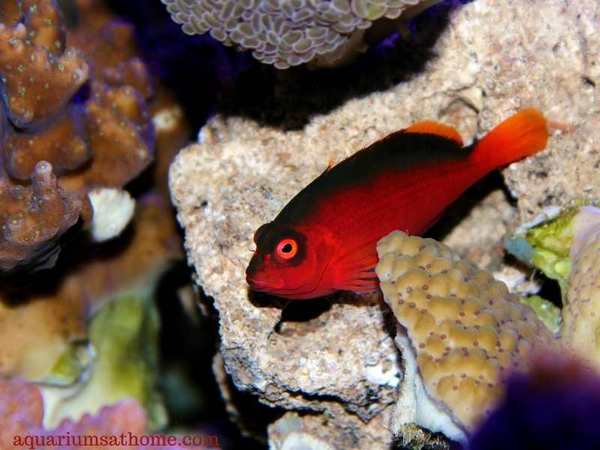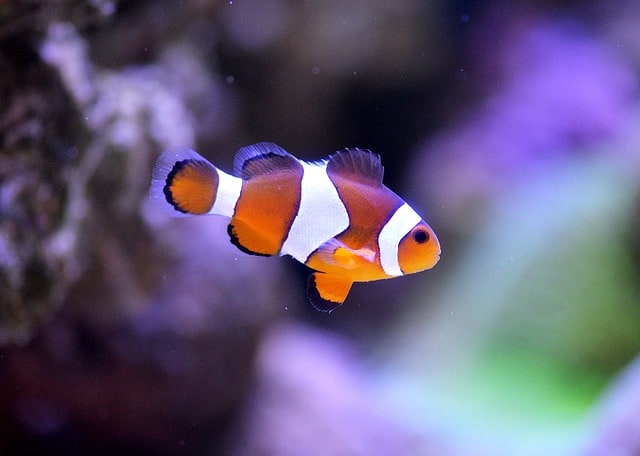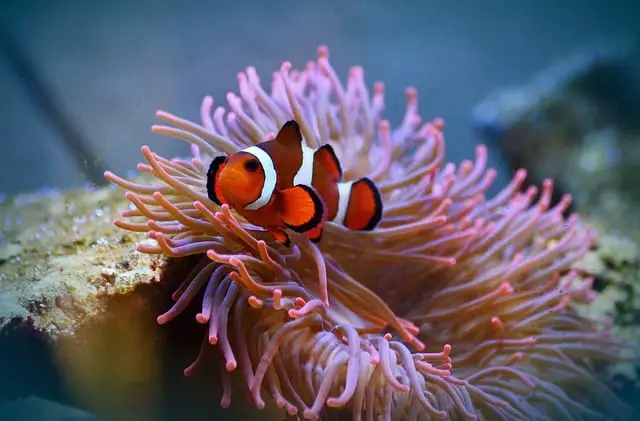Flame hawkfish are a type of marine fish found naturally in the tropical reefs of the Pacific Ocean. Their unique appearance, vibrant personality and bright red coloring make them a consummate favorite in the aquarium trade. A hardy fish that can adapt to a variety of water conditions, these bottom-dwellers make a great addition to most saltwater reef tanks.
This article will outline all you need to know as an aquarium hobbyist about basic flame hawkfish care as well as how to maintain, breed, and raise this species in captivity. I’ll explain everything – including how big of a tank they need and how to set it up; what water conditions are required; what to feed them; how long they live and how big they get; what their temperament is like; how they reproduce; how to care for offspring; and what diseases they’re prone to.
And now, let’s ‘dive deeper’ into the aquatic world of the lively and distinctive flame hawkfish…
Flame Hawkfish Overview
Behavior: semi-aggressive
Breeding: egg layer
Care level: intermediate
Diet: carnivore
Family: Cirrhitidae
Lifespan: 5-10 years
Origin: southwestern Pacific waters near Australia
Reef safe: yes
Size: 3 to 4 inches
Tank size: 30-gallon minimum
Flame Hawkfish Natural Habitat
Flame hawkfish are native to the warm, tropical waters of the southwestern Pacific Ocean off the coast of Australia, Fiji, Tahiti, and the Cook Islands. Found mainly along surge-swept reef fronts and submarine terraces, they live a peaceful, though highly predatory lifestyle among branches of live corals at depths of 3 to 30 feet.
Flame Hawkfish Appearance and Size
Flame hawkfish have bright fire-red or red-orange scales and a thick, black stripe that runs down their body from head-to-tail that looks like a mohawk. They also display a black ring around their eyes reminiscent of the black-banded eyes of the hawk bird. They can reach full-grown lengths of 3 to 4 inches with minimal girth.
Flame Hawkfish Behavior and Temperament
Flame hawkfish are semi-aggressive in temperament. They’re behavior is consistent with that of most reef fish in that they prefer to spend their time peacefully perched on top of and/or swimming through the branches of hard corals. This species can get hostile and territorial if their area is invaded which is why they need plenty of space in a contained aquatic environment.

Flame Hawkfish Diet
Flame hawkfish are carnivorous and prefer to eat meat-based live and frozen foods when in captivity. As bottom-dwellers, they like to forage along the substrate of an aquarium in search of small crustaceans and invertebrates like hermit crab and feeder shrimp. They may eat tiny fish if given the opportunity, so beware of that. As well, you can also offer them saltwater pellets as a supplementary food source.
Flame Hawkfish Lifespan
Flame hawkfish can live up to 10 years in captivity – provided the aquatic environment is clean, safe, and conducive to the conditions in their natural habitat. They’re a social fish and thrive in the company of others of their kind so when kept alone, their lifespan is often significantly less (between 5 and 7 years). To increase their lifespan, house them in a large tank in small group of 3 to 5.
Flame Hawkfish Required Water Conditions
Flame hawkfish prefer warmer water conditions and temperature ranging from 76- to 81-degrees Fahrenheit. The specific gravity should be between 1.025 and 1.026 with a pH level of 8.1 to 8.4. An alkalinity around 8 to 9 dKH with an ammonia and nitrite reading of 0ppm. This species is quite hardy and able to adapt to ‘less than perfect’ environmental parameters, provided they stay consistent.
Bio-load for this species is high, so you need to do frequent partial water changes. Removing 15 to 25 per cent of the liquid every 7 to 10 days will help keep ammonia/nitrite/nitrate levels down. If the bio-load in the tank is too high, the filter alone won’t be able to keep up with amount of waste material being generated, which can be dangerous to fish health – hence the need for weekly water changes.
Flame Hawkfish Tank Size and Setup
Flame Hawkfish are best kept in medium- to large-size tanks. A minimum of 30-gallons is required but bigger is always better when it comes to this active species. Extra space is always welcome so they can freely explore their aquatic surroundings as well as establish their territory. For multiples (one male and two females, for example), a large tank of at least 100-gallons is recommended.
The tank should also contain plenty of live rock for flame hawkfish to perch upon. The water must be well-oxygenated with a moderate current near the bottom of the aquarium. As this species is prone to ‘jumping’ out of the tank, you should change the water using a sump since sudden fluctuations in water will often startle these fish.
Best Tankmates for Flame Hawkfish
The best tankmates for flame hawkfish fish are other marine species of similar size and temperament. Clownfish, damselfish, saltwater angelfish, butterflyfish, and cardinalfish are a few possibilities. As well, choosing fish that prefer to swim in the middle or near the top of the tank, so they’ll stay out of the way of the often territorial hawkfish are also recommended.
Flame Hawkfish Sexual Characteristics.
Flame hawkfish are protogynous, which means that all are born female. They’re also hermaphroditic so they can (and will) spontaneously change sex in the absence of a male for the purposes of procreation. The biggest and most dominant female in the group will switch gender to male and proceed to mate with the remaining females.
Breeding Flame Hawkfish
When flame hawkfish are ready to breed they usually do shortly after dusk near the surface of the water. Spawning begins with the typical courtship rituals such as the male chasing the female about the tank. After mating, the female releases hundreds of buoyant eggs which are fertilized promptly by the male. These fertilized eggs are then left unattended to hatch on their own in approximately 3 weeks.
To initiate flame hawkfish breeding, you must ensure the tank is large enough to house at least a mated pair. They’re not the most tolerant of each other and need plenty of space to avoid becoming hostile. For this reason, you should increase your aquarium size to a minimum 80-gallons (100-gallons is better). The water parameters must be ideal and you should feed them nutritious meat-based foods as well.
Once you observe the courtship rituals taking place, keep an eye out for eggs floating near the surface. Following fertilization, you’ll need a separate breeder tank to incubate the eggs and allow fry to hatch safely since flame hawkfish eat their own young! Collect the eggs gently and then transfer them to the breeder tank. Mark your calendar for 3 weeks from the egg-gathering date.
Caring for Flame Hawkfish Offspring
To properly care for flame hawkfish fry, you must ensure the water conditions are conducive to this species requirements and comparable to that of the main tank. A secure lid is necessary along with a filter, heater, and aquarium light. Babies will grow quickly on a protein-rich diet of brine shrimp and copepods offered 2 to 3 times a day.
Water changes must be done frequently as the babies grow since they’re much more sensitive to fluctuating water conditions than their parents. Test the water quality regularly and make sure all equipment is running optimally. If you notice a dead fish, remove it immediately as the decaying material is detrimental to fry health.
It’s important to note that juveniles cannot be moved into the main tank with the established flame hawkfish. The adults won’t accept the youngsters and they’ll attack! The only way they can live in that aquarium is if the existing flames have passed away. Therefore, you shouldn’t breed this species unless you know in advance you have a separate tank to raise them or another hobbyist willing to take them. Top of Form
Flame Hawkfish Cost
Depending on where you live, the price of purchasing flame hawkfish will vary. On average, small fish (less than 1-inch long) cost around $70 whereas medium-sized fish (1 to 3 inches long) ring in at around $80 and large fish (over 3 inches long) cost about $90. Like many saltwater fish, they’re more expensive to buy and maintain than most freshwater fish.
Common Flame Hawkfish Diseases
Flame hawkfish are susceptible to a disease known as uronema. It’s caused by a ‘free living’ parasite and results in red sores and/or gill discoloration. Fish infected with this illness often swim about erratically while making sharp head movements near the surface of the tank water. For this reason, uronema is often referred to as ‘swimmer’s disease.’
To treat this infection, move the infected fish from the main aquarium to a quarantine tank. Feed the fish food soaked in metronidazole to prevent the disease from spreading internally. Treat the fish with medication once every 48 hours for 10 to 14 days to ensure all parasites have been expunged. Once the sores are gone and the fish appears to be well, move it back to the main aquarium.
Marine ‘ich’ or ‘white spot disease’ is one of the most common diseases infecting saltwater fish, including flame hawkfish. Caused by a parasite, this illness results in loss of appetite, abnormal hiding behavior, lethargy, respiratory distress, and even death. To treat it, sick fish must be moved to a separate tank and dosed regularly with copper-based medication as per the manufacturer’s instructions.

Flame Hawkfish Special Recommendations
Flame Hawkfish come with their own set of criteria for care and well-being. One thing to be aware of is that even though they’re bottom-dwellers, they do swim up to the surface on occasion and have been known to jump out of their tank! Like wrasses, they should be kept in a tank with a tight-fitting lid. Flame hawkfish spook easily so pay extra attention to their whereabouts when cleaning the aquarium.
When it comes to keeping flames with other species of hawkfish, the consensus seems to be that they’ll do just fine in the same tank – provided it’s large enough so that each fish can claim its own territory. Hawkfish, no matter the species, are territorial and will get hostile towards others in a crowded aquatic environment. Adding additional decorations will provide cover and act as territory markers for fish.
Are Flame Hawkfish Hardy? (Easy to Keep)?
As mentioned at the beginning of the article, flame hawkfish are indeed a hardy species. With the right water conditions and tankmates, I’d say that yes, they are also easy to keep. As with all pet fish, well maintained tanks make all the difference in how healthy the fish will be. In general, though the flame hawkfish is a genetically hardy fish and will tolerate swings in water parameters, this doesn’t mean you can let your tank conditions slide.
Pros and Cons of Flame Hawkfish
Pros
- flame hawkfish are a hardy marine species that are quite resistant to disease – provided they’re well cared for and kept in a clean, safe environment with adequate water parameters.
- flame hawkfish get along well with most other like-sized species of reef fish with similar temperaments, especially those that stay in the middle or near the surface of the tank.
- flame hawkfish can be breed successfully in captivity under the right aquatic circumstances and with proper care and preparation.
- flame hawkfish are unique, vibrant, and a joy to observe it captivity – their bright coloring and active nature make them a welcome addition to most saltwater reef tanks.
Cons
- flame hawkfish are considered reef safe however, they like to perch on top of corals which can stress polyps.
- flame hawkfish can be difficult to feed in captivity– becoming ‘picky’ and even refusing food entirely.
- flame hawkfish are territorial and can become aggressive if other fish invade their spade near the bottom of the tank.
- flame hawkish contribute to a high bio-load which makes for additional maintenance, such as consistent water changes, frequent water testing, and regular equipment checks.
Final Thoughts
To sum things up, flame hawkfish (aka brilliant red hawkfish) are a species of saltwater reef fish originating in the coastal waters of French Polynesia all the way down to the Great Barrier Reef in Australia. Their unique shape, lively personality, brilliant coloring, and hardy nature make them a favorite choice among marine aquarium hobbyists.
I trust this article has provided you with all the information you need to successfully keep, breed, and raise happy and healthy flame hawkfish in captivity. Thanks for reading and good luck with your future aquarium hobbyist endeavors.
Related Posts
Will Hawkfish Eat Cleaner Shrimp?
Are Yellow Tangs Hard to Keep?
Can You Keep a Lionfish in a Reef Tank?
Are Blue Tangs Difficult to Keep?
How to Get Rid of Bristle Worms?






